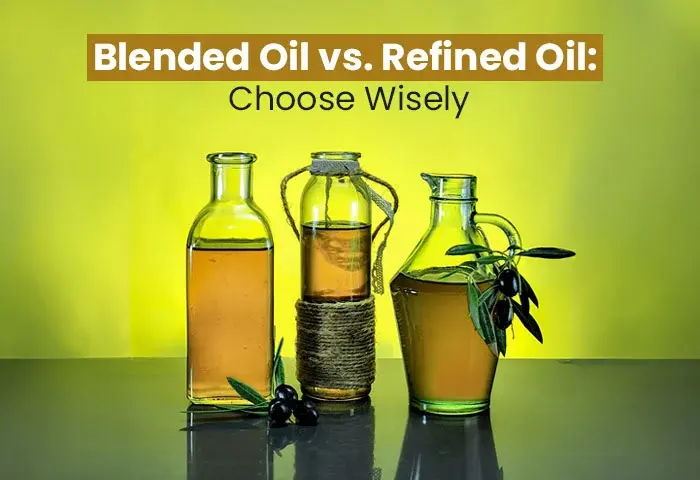In the realm of culinary choices, the type of cooking oil we use plays a crucial role in determining not just the flavor of our dishes but also the impact on our overall health. With the plethora of options available on the market, it’s essential to make informed decisions about the oils we incorporate into our daily cooking routines. Two prominent contenders in this arena are Blended Oil and Refined Oil. While both offer distinct advantages, understanding the nuances between them is key to making a choice that aligns with your health and culinary goals.
In this blog, we will explain about Blended Oil and Refined Oil, unraveling their compositions, benefits, and potential drawbacks. The differences between these cooking oils help you make an educated choice that not only elevates the flavors of your favorite dishes but also contributes to a healthier lifestyle.
Which is Better Refined or Blended Oil?
Refined Oil:
- Processing: Refined oils go through a process of filtering and purifying to remove impurities and unwanted elements. This often involves the use of chemicals and heat.
- Flavor and Aroma: Refined oils generally have a neutral flavor and aroma, making them suitable for a wide range of cooking applications without imparting a strong taste to the food.
Blended Oil:
- Composition: Blended oils are a combination of different types of oils, often designed to create a balance of flavors, nutrients, and cooking properties.
- Flavor and Aroma: Depending on the specific blend, these oils can offer a more complex and nuanced flavor profile compared to refined oils.
- Nutritional Content: Blended oils may retain some of the nutritional benefits of the original oils used in the blend, providing a mix of different fatty acids.
What is Blended Oil?
Blended oil refers to a combination of different types of oils, often created by mixing two or more oils to achieve specific qualities or desired characteristics. This blending process can be done for various reasons, such as enhancing flavor, increasing smoke point, improving nutritional profile, or achieving a more balanced fatty acid composition.
Key Benefits of Blended Oils
- Enhanced Flavor: Blended oils can offer a unique and balanced flavor profile that combines the best characteristics of each individual oil.
- Improved Nutritional Profile: By blending different oils, it’s possible to create a product with a more diverse array of essential fatty acids, vitamins, and antioxidants, contributing to a healthier overall nutritional profile.
- Cost-Effectiveness: Blending oils can be a cost-effective way to create a product that possesses desirable qualities without the higher price tag associated with some premium oils.
Check out our guide on cooking oil for weight Loss. Start your transformation today!
What is Blended Oil Used For?
- Cooking and Frying: Blended oil with a high smoke point, achieved by combining oils like canola and sunflower, is suitable for high-temperature cooking methods such as frying and sautéing. This makes it versatile for a range of recipes, from stir-fries to deep-frying.
- Salad Dressings: Blended oils with a mix of olive oil and other vegetable oils can be used to create well-balanced salad dressings. The blend can provide a pleasant taste profile while maintaining the health benefits associated with olive oil.
- Baking: Blended oils can be used in baking to add moisture and enhance the flavor of baked goods. A combination of oils like canola and olive oil might work well in various recipes, such as cakes, muffins, and cookies.
- Marinades and Grilling: Blended oils with a mix of different flavors, like olive oil and sesame oil, can be used for marinating meats or vegetables before grilling. This imparts a unique taste and helps in tenderizing the ingredients.
- Health Considerations: Blending oils allows for a combination of monounsaturated, polyunsaturated, and saturated fats, providing a more balanced fatty acid profile. This can contribute to a healthier oil option when used in moderation.
Is Blended Oil Good For Frying?
Blended oil, which typically consists of a mix of different oils, can be a good choice for frying depending on the specific oils used in the blend. The goal of using blended oil is to combine the desirable characteristics of different oils, such as flavor, smoke point, and nutritional profile.
What is refined oil?
Refined cooking oils are types of cooking oils that undergo a process called refining to enhance their quality, taste, and nutritional properties. The refining process involves various stages such as degumming, neutralization, bleaching, and deodorization, which help remove impurities, undesirable flavors, and odors from the raw oil.
Benefits of Using Refined Cooking Oils
- Improved Flavor and Aroma: Refined cooking oils have a milder flavor and aroma compared to their unrefined counterparts. The refining process removes impurities and compounds that contribute to strong or undesirable tastes, resulting in a more neutral and versatile cooking oil.
- Higher Smoke Point: The refining process typically raises the smoke point of cooking oils. A higher smoke point means that the oil can withstand higher cooking temperatures before breaking down and producing smoke. This makes refined oils suitable for a variety of cooking methods, including deep-frying and stir-frying.
- Extended Shelf Life:The removal of impurities during the refining process contributes to a longer shelf life for refined cooking oils. The reduction of substances that can lead to rancidity helps maintain the oil’s freshness over an extended period.
- Nutrient Retention: While refining removes some natural compounds from the oil, it also helps retain essential nutrients like vitamin E. Refined oils can still provide a good source of healthy fats and nutrients, making them a practical choice for those seeking balanced nutrition in their cooking oils.
- Enhanced Appearance: The refining process often results in a clearer and lighter-colored oil, which can enhance the appearance of cooked dishes. This can be particularly beneficial when preparing visually appealing dishes where the color and clarity of the oil play a role.
- Reduced Allergen Content: The refining process may reduce the presence of allergenic proteins, making refined cooking oils a safer option for individuals with certain food allergies.
Parting Thoughts
The choice between blended oil and refined oil ultimately depends on individual preferences, health considerations, and culinary needs. Blended oils offer a balance of flavors and nutritional benefits, combining different types of oils to create a versatile option. On the other hand, refined oils undergo a thorough purification process, resulting in a neutral taste and higher smoke point, making them suitable for various cooking methods.
Consider your specific cooking requirements, dietary goals, and taste preferences when making a decision. Both blended and refined oils have their merits, so choosing wisely involves understanding your priorities and selecting the option that aligns best with your culinary lifestyle. Whether you prioritize flavor, nutritional content, or cooking versatility, making an informed choice will contribute to healthier and more enjoyable culinary experiences.
Buy SVR’s Rice Bran Oil, a top-quality product, and experience the exceptional quality of their offerings.
FAQ’s
Q: Can we mix two edible oils together?
A: Yes, you can mix two edible oils together. It’s safe to blend oils for cooking, but consider the smoke points and flavor compatibility.
Q: Which is the healthiest oil for frying?
A: Olive oil is a good choice for frying due to its high monounsaturated fats. Other options include rice bran oil and canola oil. Avoid oils with low smoke points for frying.

